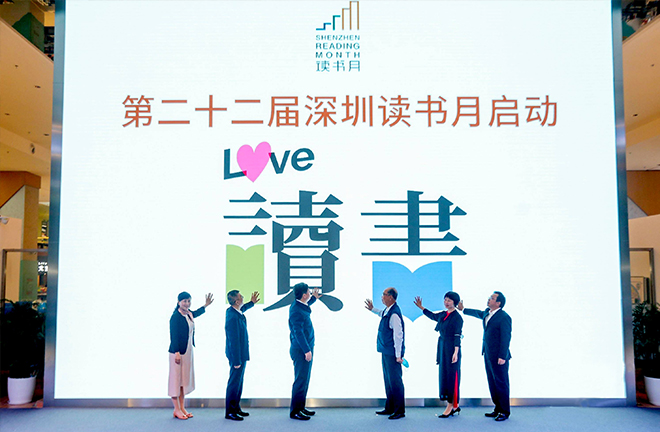
FILE PHOTO: The launching ceremony of the 22nd Shenzhen Reading Month took place on Nov. 2, 2021.
In the Literature Talks magazine, several articles were published in 2021 addressing the question “why has there been no great literary work in Shenzhen?” Some consider that the fundamental reason lies in Shenzhen’s “culture of efficiency,” since great works are a result of long-term toil, which is rooted in profound cultural elements accumulated over a long time span, rather than leap-forward strides. Some believe that Shenzhen lacks cultural confidence, because people do not perceive the strength of its native literature. Others think that Shenzhen, as “the fastest growing metropolis in the world,” lags behind in literature.
It is difficult to reach a consensus on the issue of “great-work absence” in Shenzhen, because people have different understandings of how “great work” should be defined. To evaluate whether “great work” exists in certain places, we need to observe the course of native literary development in these locations and observe the native cultural landscape. In this regard, I consider the above opinions about Shenzhen literature biased.
Literary context in Shenzhen
Shenzhen leapt from a small fishing village to a metropolis in just over forty years. This means that Shenzhen has only 40+ years of history as a city. In addition, the people who live, work, and reside in the city are young. Such a young city naturally lacks “profound cultural accumulation.”
Moreover, Shenzhen is a city mostly of domestic immigrants, most of whom migrate from other cities. What is the goal of outsiders who migrate to Shenzhen? It is for start-ups, to conduct business, work for a living, and so forth, but not to write—because one does not need to relocate to Shenzhen if one aspires to be a writer. In other words, the vast majority of people who live in Shenzhen, at least in the beginning, are busy struggling for their livelihoods and working hard to develop their careers. Writing may be a hobby for a few people who have overcome the challenges of making a living, and these amateurs do not have a compulsive self-motivation for writing.
As some argue, the culture of Shenzhen is a culture of efficiency. “Time is money, efficiency is life” is not just a slogan in Shenzhen, but a law followed by all people (whether government officials or the general public). Just imagine, in such a setting of a speedily operating city with an extremely fast pace of life, what would people’s state of mind be? Is there any conflict between this mental state and writing?
A truly good work needs to be tested by time, which should take at least 30, 50, or even 100 years. From this point of view, it is too early to discuss whether Shenzhen has produced or can produce “great works.”
Shenzhen’s own literary seeds
When talking about Shenzhen’s literature, we may come to a different conclusion if we enlarge our view to the holistic literary and cultural environment instead of confining ourselves to discuss specific works.
Shenzhen also has its own literary “seeds” cultivated by the city itself. For example, the Shenzhen Book Month, which was founded in 2000, has been held for 22 years, with branded events such as “Bookcrossing” and the “Shenzhen Writers of the Year.” Many famous writers such as Mo Yan, Jin Yong, and Er Yuehe, were invited to participate. In 2013, the United Nations Educational, Scientific and Cultural Organization (UNESCO) awarded Shenzhen the title of “Global Model City for Reading.”
In addition, the “Good-Neighborly Literary Prize” which was established in Shenzhen in 2013 is an exclusive award to motivate all the local people and their writing practices. “Such persistence is of nobility,” “the prize has inspired many outsiders to regard Shenzhen as their hometown,” “it gives courage to many amateurs who wander outside the palace of literature” —these words are from the guests who attended the 2021 award ceremony for the prize, and these quotes offer the best summary of this cultural event.
Diversified literary appearances
Shenzhen once led the migrant literature trend, and a number of representative figures in migrant literature emerged, such as Lin Jian, Zhang Weiming, Dai Bin, Zeng Chuqiao, Xie Xiangnan, and more. In addition, Xu Jingya, Wang Xiaoni, Deng Yiguang and many other influential and eminent writers and poets of different ages have been active in Shenzhen or are still active in the city.
Writings about Shenzhen allow people to witness the diversified appearances of Shenzhen literature. Over the past 40+ years, writers from Shenzhen have carried out pioneering practices in the fields of migrant literature, urban literature, online literature, and other forms of literature, leaving a unique and distinct footprint on the contemporary literary circle.
It should be noted that the Shenzhen culture is a type of culture that is still in the process of being generated and constructed and is flourishing with vitality. With such a cognitive basis, there should be no more anxiety about “great works.” As the Chinese writer and critic Xie Youshun said: “In addition to the empirical meanings of Shenzhen, we should also understand Shenzhen in the intellectual and imaginative sense...the city is not only a material, social, or technological space, but also a literary space—if the complex feelings and confusions within people’s mind in this space can be written, Shenzhen, as a sample of literary narrative, will surely leave a more important imprint on the map of Chinese literature.”
Zhu Yuwen is an associate research fellow from the Department of Cultural and Literary Theory at Art Institute of Foshan and deputy director of Foshan Literary and Art Critics Association.
Edited by BAI LE

